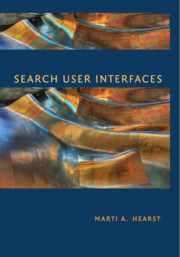Book contents
- Frontmatter
- Contents
- Preface
- 1 The Design of Search User Interfaces
- 2 The Evaluation of Search User Interfaces
- 3 Models of the Information Seeking Process
- 4 Query Specification
- 5 Presentation of Search Results
- 6 Query Reformulation
- 7 Supporting the Search Process
- 8 Integrating Navigation with Search
- 9 Personalization in Search
- 10 Information Visualization for Search Interfaces
- 11 Information Visualization for Text Analysis
- 12 Emerging Trends in Search Interfaces
- Appendix: Additional Copyright Notices
- Bibliography
- Index
- Author Index
- Plate section
12 - Emerging Trends in Search Interfaces
Published online by Cambridge University Press: 05 March 2013
- Frontmatter
- Contents
- Preface
- 1 The Design of Search User Interfaces
- 2 The Evaluation of Search User Interfaces
- 3 Models of the Information Seeking Process
- 4 Query Specification
- 5 Presentation of Search Results
- 6 Query Reformulation
- 7 Supporting the Search Process
- 8 Integrating Navigation with Search
- 9 Personalization in Search
- 10 Information Visualization for Search Interfaces
- 11 Information Visualization for Text Analysis
- 12 Emerging Trends in Search Interfaces
- Appendix: Additional Copyright Notices
- Bibliography
- Index
- Author Index
- Plate section
Summary
This chapter describes several areas that are gaining in importance and are likely to play a significant role in search interfaces in the future. These predictions come primarily from extrapolating out from emerging trends. The areas that seem most likely to be important, and so demand changes in search interface technology, are: mobile search, multimedia search, social search, and a hybrid of natural language and command-based queries in search. Each is discussed in detail below.
Mobile Search Interfaces
Mobile communication devices are becoming increasingly popular as information access tools. A recent survey of more than 1,000 technology leaders and other stakeholders said they expect that mobile devices will be the primary connection tool to the Internet for most people in the world in 2020 (Rainie 2008). They also predict that voice recognition and touch user interfaces will be more prevalent and accepted by 2020. Usable interfaces for search on mobile devices are only now beginning to emerge, but this area will most certainly undergo rapid development and innovation in the next few years.
Until recently, mobile devices had small screens, awkward text input devices, and relatively low bandwidth, which pose challenges for information-rich applications like search. However, bandwidth is increasing, and the recent appearance of personal digital assistants (PDAs) with relatively large, high-resolution screens, such as the Apple iPhone, are making search on mobile platforms feel more like desktop-based Web search.
- Type
- Chapter
- Information
- Search User Interfaces , pp. 297 - 324Publisher: Cambridge University PressPrint publication year: 2009
- 1
- Cited by



